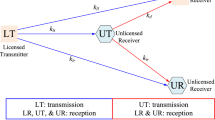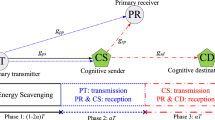Abstract
This paper proposes an overlay network wherein a pair of licensed source (LS) and licensed destination (LD) is adaptively assisted by a pair of unlicensed source (US) and unlicensed destination (UD). By processing adaptively at US and UD relied on the decoding statuses of LD and US, licensed communication is always supported with a high diversity gain from which unlicensed communication also benefits from removing licensed interference as well as transmitting with the highest available power, eventually improving reliability of both unlicensed and licensed communication. This paper also proposes closed-form formulas of outage probabilities at LD and UD for prompt reliability evaluation over \(\kappa -\mu \) shadowed fading channels. Multiple results illustrate the superiority of the proposed adaptive processing scheme as compared to its counterpart. Further, the reliability of the suggested scheme can be flexibly controlled and optimized with setting specifications reasonably.





Similar content being viewed by others
Notes
Recent advances in self-interference cancellation enable UD to accomplish about 80-110 dB of self-interference suppression [31]. Accordingly, \(\eta \) is very small.
The current paper supposes the case that \(UD \) implements restoring \(x_s\) merely if it has restored exactly \(x_p\). The criterion to assure whether \(UD \) has decoded correctly \(x_p\) is described in the subsequent section. Thence, the residual licensed interference remained after removing \(x_p\) out of \(UD \)’s received signal is negligible.
To mitigate case-studies without loss of generality, an identical shadowed fading parameter set - (\(\mu _{\textsf {uv}}=\mu \), \(m_{\textsf {uv}}=m\), \(\kappa _{\textsf {uv}}=\kappa \)) - for any channel is studied in the sequel.
Diversity order is defined as the slope of the outage probability curve.
References
Tataria, H., et al. (2022). Six critical challenges for 6g wireless systems: A summary and some solutions. IEEE Vehicular Technology Magazine, 17(1), 16–26.
Osorio, D. P. M., et al. (2022). Towards 6G-enabled internet of vehicles: Security and privacy. IEEE OJCS, 3, 82–105.
Sizer, T., et al. (2022). Integrated solutions for deployment of 6G mobile networks. Journal of Lightwave Technology, 40(2), 346–357.
Ge, Y., et al. “Energy efficiency for proactive eavesdropping in cooperative cognitive radio networks,” IEEE IoT Journal To appear.
Le-Thanh, T., et al. “Overlay networks with nonlinear energy scavenging and noma-assisted decoding: security performance analysis,” Arabian Journal for Science and Engineering To appear.
Khorov, E., et al. (2022). A phase noise resistant constellation rotation method and its experimental validation for NOMA wi-fi. IEEE JSAC, 40(4), 1346–1354.
Rezvani, S., et al. (2022). Optimal power allocation in downlink multicarrier NOMA systems: Theory and fast algorithms. IEEE JSAC, 40(4), 1162–1189.
Jee, A., et al. “Performance of adaptive multi-user underlay NOMA transmission with simple user selection,” IEEE Transactions on Cognitive Communications and Networking To appear.
Tran, G. N., et al. (2022). Performance analysis of short packets in NOMA VLC systems. IEEE Access, 10, 6505–6517.
Campello, R., et al. (2021). Successive interference cancellation decoding with adaptable decision regions for NOMA schemes. IEEE Access, 10, 2051–2062.
Hota, P. K., et al. (2022). Ergodic performance of downlink untrusted NOMA system with imperfect sic. IEEE Communication Letter, 26(1), 23–26.
Wu, L., et al. (2022). Temporal correlation enhanced sparse activity detection in MIMO enabled grant-free NOMA. IEEE Transaction Vehicular and Technology, 71(3), 2887–2899.
3GPP RP–170829, New Study Item proposal, Study on non–orthogonal multiple access for NR, ZTE, CATT, Intel, Samsung, (Mar. 2017).
Lopez-Martinez, F. J., et al. (2017). The \(\kappa \)- \(\mu \) shadowed fading model with integer fading parameters. IEEE Transaction Vehicle Technology, 66(9), 7653–7662.
Miridakis, N. I., et al. (2019). “Green CR-NOMA: A new interweave energy harvesting transmission scheme for secondary access,” in Proceeding ISWCS, 21 Oct. 2019, Finland, pp. 571-576.
Le-Thanh, T., et al. “Effect of hardware imperfections and energy scavenging non-linearity on overlay networks in \(\kappa \)-\(\mu \) shadowed fading,” Arabian Journal for Science and Engineering To appear.
Singh, I., et al. (2020). Outage probability and ergodic channel capacity of underlay device-to-device communications over \(\kappa -\mu \) shadowed fading channels. Wireless Network, 26, 573–582.
Le, Q. N., et al. (2021). Full-duplex non-orthogonal multiple access cooperative overlay spectrum-sharing networks With SWIPT. IEEE Transaction Green Communication Network, 5(1), 322–334.
Ho-Van, K., et al. (2021). Security improvement for energy harvesting based overlay cognitive networks with jamming-assisted full-duplex destinations. IEEE Transaction Vehicle Technology, 70(11), 12232–12237.
Hanh, D. N., et al. (2021). Secrecy analysis of overlay mechanism in radio frequency energy harvesting networks with jamming under Nakagami-m fading. Wireless Personal Communicatiom, 120, 447–479.
Ho-Van, K., et al. (2021). Impact of artificial noise on security capability of energy harvesting overlay networks. Wireless Communication and Mobilizing Computation, 2021, 1–12.
Ho-Van, K., et al. (2021). Impact of channel estimation-and-artificial noise cancellation imperfection on artificial noise-aided energy harvesting overlay networks. Telecommunication System, 78, 273–292.
Ho-Van, K., et al. (2021). Overlay networks with jamming and energy harvesting: Security analysis. Arabian Journal for Science and Engineering, 46, 9713–9724.
Solanki, S., et al. (2020). Performance analysis of piece-wise linear model of energy harvesting-based multiuser overlay spectrum sharing networks. IEEE OJ-CS, 1, 1820–1836.
Li, F., et al. (2019). Cognitive non-orthogonal multiple access with energy harvesting: An optimal resource allocation approach. IEEE Transaction Vehicle Technology, 68(7), 7080–7095.
Agrawal, K., et al. (2020). NOMA With battery-assisted energy harvesting full-duplex relay. IEEE Transaction Vehicle Technology, 69(11), 13952–13957.
Shukla, A. K., et al. (2021). Performance analysis of energy harvesting-assisted overlay cognitive NOMA systems with incremental relaying. IEEE OJCOMS, 2, 1558–1576.
Singh, C. K., et al. “Energy harvesting in overlay cognitive noma systems with hardware impairments,” IEEE System Journal To appear.
Nguyen, B. V., et al. (2018). Performance analysis of a cognitive radio network with an energy harvesting secondary transmitter under Nakagami-\(m\) fading. IEEE Access, 6, 4135–4144.
Li, M., et al. (2019). Improving the security and spectrum efficiency in overlay cognitive full-duplex wireless networks. IEEE Access, 7, 68359–68372.
Bharadia, D., et al. (2013). Full duplex radios. SIGCOMM Computational Communication Review, 43(4), 375–386.
Wang, D., et al. (2020). Performance analysis and resource allocations for a WPCN with a new nonlinear energy harvester model. IEEE OJCOMS, 1, 1403–1424.
Riihonen, T., et al. (2011). Mitigation of loopback self-interference in full-duplex MIMO relays. IEEE Transaction Signal Processing, 59(12), 5983–5993.
Abramowitz, M., et al. (1972). Handbook of mathematical functions with formulas, graphs, and mathematical tables, Tenth printing ed., Washington, DC, USA: U.S. Government Printing Office.
Thomopoulos, N. T. (2013). Essentials of Monte Carlo simulation: Statistical methods for building simulation models. London: Springer.
Acknowledgements
We acknowledge Ho Chi Minh City University of Technology (HCMUT), VNU-HCM for supporting this study.
Author information
Authors and Affiliations
Corresponding author
Additional information
Publisher's Note
Springer Nature remains neutral with regard to jurisdictional claims in published maps and institutional affiliations.
Rights and permissions
Springer Nature or its licensor holds exclusive rights to this article under a publishing agreement with the author(s) or other rightsholder(s); author self-archiving of the accepted manuscript version of this article is solely governed by the terms of such publishing agreement and applicable law.
About this article
Cite this article
Le-Thanh, T., Ho-Van, K. Adaptive processing in overlay networks for performance improvement. Wireless Netw 28, 3639–3652 (2022). https://doi.org/10.1007/s11276-022-03089-4
Accepted:
Published:
Issue Date:
DOI: https://doi.org/10.1007/s11276-022-03089-4




